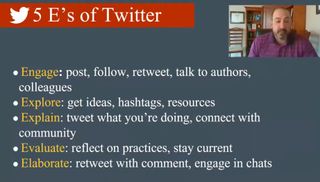With schools closed and remote learning becoming the norm, our teachers have gone from saying, “Please raise your hand” to “Click the hand-raising icon to participate and then unmute yourself.”
No professional development day or session could have prepared us for this dramatic shift. As educational leaders, we sprinted to support teachers with ideas, lessons, and support. But now, a month into remote learning, it’s no longer a sprint; it’s looking more and more like a marathon.
Technology trainers need to create a long-term plan to support educators and encourage the effective use of digital tools for instruction. Online meetings and digital communication have become the norm for providing learning opportunities to educators now. Having strategies for virtual training will make these opportunities more impactful.
In developing a long-range PD schedule, ask yourself the following questions to ensure sessions match needs:
- What are the session goals?
- Are the topics aligned with the district’s vision and goals?
- Who is the target audience for each session?
- How does this training align with existing PD opportunities?
- Who can I invite others to facilitate or co-present?
- How often, and by whom, will follow-up be provided?
Ideally, any ongoing PD should be scheduled at the same time every week for consistency and routine. You can send an email invitation containing the virtual meeting link and any supporting documentation to all participants well in advance.
So you can focus on delivering content and pacing during a session, assign “co-presenter” roles to colleagues to help keep the meeting on track. Roles may include:
Moderator: Watches the virtual room for hand raising and reads the chat thread for questions. The moderator can inform the presenter there is a question and ask for him/her to pause.
Notetaker: Records main takeaways and emails it to everyone after training.
Technical support: Troubleshoots problems for participants who cannot connect. Tech support can send private messages or place calls to participants without slowing down PD for everyone else.
Small group facilitator: Leads small group virtual breakout sessions after the PD training.
Timekeeper: Keeps things moving and the session to the time allotted. There is no bigger turnoff to virtual PD sessions than running over the stated time.

Other key elements to include to ensure your virtual PD are a success:
Have fun! We want teachers to see the value in virtual learning lessons. Having fun will show your vulnerability and ease participants' nerves. Laughing makes any time more impactful.
Meet educators where they are. Often, online meetings or virtual PD sessions go too fast because a presenter assumes participants know the basics. Just like students, each educator has a different ability level. When preparing any session, be mindful of the ability level of the audience. Use clear topics for these PD sessions so the audience knows what level to expect, such as “Getting Started with Flipgrid” or “Advanced Google Tools.” You can also send out a survey of needs before the session.
Being a learner can be stressful. When educators are learning anything new, they need time to digest the concept and work with the skill. Many are also attending a virtual PD session for the first time. Never overschedule the time with “new learning” and remember that remote learning itself is new to most educators. Keep virtual training sessions to less than an hour. Be sure to leave at least 10 minutes at the end of the training session to answer any questions.
Be prepared. Just as with a classroom lesson, PD facilitators must plan and prepare for PD. My general rule of thumb is it takes two hours of planning for every one-hour session. During the planning process, focus on the agenda, how the learning will be structured, transitions between topics, and the closure.
Don’t over plan. Limit topics for each training session to just one skill per session so participants leave feeling empowered, not overwhelmed. Include specific examples of how to implement the taught skill and encourage attendees to practice the skill in their work each week.
Be a facilitator. The PD instructor is guiding educators in learning, not simply giving them a “how-to” presentation. Make sure you are allowing ample time for discussion and questions.
Use participant experiences. As the facilitator, you won’t always have all the answers. If you are introducing a tool, invite some educators who have used it to share their experience and allow participants to ask questions about how they might use the tool in their lessons.
Celebrate. End the session by celebrating things that went well, either with the content itself, the delivery of the material, or the positivity in the learning environment. You could offer a certificate to indicate completion or share a fun JibJab. I also like to end sessions showcasing some of the work shared by educators in the session.
When planning virtual PD, remember to start and end on time, practice with the technology you will use to run the session beforehand, and use the participants as resources both for your delivery of the virtual session and the content.
When in doubt, go back to strategy one: HAVE FUN. This is new for all of us, and having fun is the foundation of success. Modeling a successful remote learning environment can be a great way to build a unique trust with your staff.
Feel free to join any of my sessions on Friday at 1:00 by adding your name to the signup form. Click here to sign up and a Meet link will be sent Friday mornings and a summary of session and resources emailed Sunday following the session. Or click here for some Virtual PD support.

Dr. Matthew X. Joseph is the Director of Curriculum, Instruction, and Assessment in Leicester Public Schools. He has been a school and district leader in many capacities in public education over his 25 years in the field. He is the author of Power of Us: Creating Collaborative Schools and co-author of Modern Mentoring, Reimagining Mentorship in Education. Follow him on Twitter @matthewxjoseph and visit his blog: techinnovation.live

